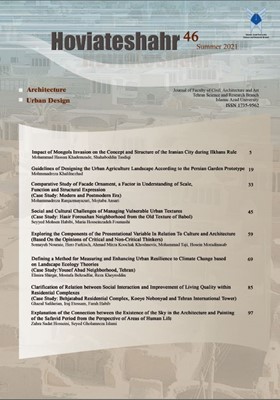Exploring the components of presentational in relation to culture and architecture based on the opinions of critical and non-critical thinkers
Subject Areas : architecture
Somayeh Nouraie
1
,
Hero Farkisch
2
,
Ahmad mirza koochak Khoshnevis
3
,
Mohammad Taji
4
,
Hosein Moradinasab
5
![]()
1 - Ph,D. Candidate in Architecture, Department of Architecture, Semnan Branch, Islamic Azad University, Semnan, Iran.
2 - Assistant Professor, Department of Architecture, Mashhad Branch, Islamic Azad University, Mashhad, Iran
3 - Assistant Professor, Cultural Heritage and Tourism Research Institute, Iran.
4 - Assistant Professor, Department of Mining, Shahroud Branch, Islamic Azad University, Shahroud, Iran
5 - Assistant Professor, Department of Architecture, Semnan Branch, Islamic Azad University, Semnan, Iran
Keywords: Critical, architectural, Non- critical, The Presentational variable, cultural,
Abstract :
Today’s chaotic and disturbed changes in the field of architecture in Iran have more dependent variables on cultural elements and sociology, rather than from aesthetics or necessity-based requirements of architectural engineering. In this paper, the relation between the form of the house and architecture with the elements of sociological and cultural is examined. One of the factors that affect the cultural-social aspects of the architecture is the "presentational" variable that is facing a lack of cultural considerations in our country. For the first time, the presentational variable entitled as "Dramatic Cultural" in 1959 AD was the use of the concept of the show as a metaphor of cultural demonstrations in societies. This issue in architecture, as part of material culture, defines architecture in relation to another, which reflects a wide range of meanings that are dependent on its supporting philosophy of thought. However, it covers that part of the architectural necessities that are not actually generated by the user themselves, but in response to the other, the user either requires or has to respond to the architecture. Therefore, understanding the relation of the presentational variable with architecture is part of the understanding of the relation of culture and architecture. Nowadays, the dramatic architecture in society as a public affair is a barrier to policy-making with a cultural challenge in the field of architecture. From the point of view of culturalism, presentational variable has associated with cultural while culture affected from time and field, can be derived from each of the cultural layers or areas; ideological culture (Culture of specialist forces, books and articles), custom culture (Common culture), elite culture (Imported culture) or foreign culture (Religion and Nationality). The purpose of this research is to identify the various components of the presentational variable in relation to culture and architecture. The research method in this study is an analytical-interpretative one. At first, the concepts of the Presentational variable are extracted from the texts and views of the relevant scholars (influenced by the views of the thinkers of the critical and uncritical pole), and then the components of the Presentational variable are presented in the form of a conceptual model, and finally, in a comparative view, it has been discussed and concluded. The results of the research show that the presentational variable is related to today’s cultural view, due to the "loyalty" affected by "the deepening growth of the media". On the one hand, as a reality based on power, wealth, media, and modern technologies, imposes a distinction on society. On the other hand, this issue contrasts with the traditions and customs of our society, such as simple life. The evidence available in the architecture of today's Iranian society, shows that the presentational variable in architecture follows popular culture more than any other culture. Of course, proving this claim can be a question for future research. In conclusion, it is certain that architecture derived from customary culture was inadequate in terms of value, and in today's Iranian society, art and architecture should be supported by elite and ideal cultures.
بودریار، ژان. (1395). جامعه مصرفی. چاپ ششم. (پیروز ایزدی، مترجم). تهران: ثالث. (نشراثراصلی 2007).
بوردیو، پییر. (1393). تمایز: نقد اجتماعی قضاوتهای ذوقی. (حسن چاوشیان، مترجم). تهران: ثالث.
تاج بخش، گلناز. (1383). والتر بنیامین: دگرگونی تجربه وخاطره درعصرجدید وکلانشهر مدرن. نشریه هنرهای زیبا، (20)،5-16.
جباری، اکبر. (1394). دازاین کاوی یا تحلیل دازاین. تهران: پرسش.
حجت، مهدی. (1396). ایران کدام معماری. بازیابی 9 اردیبهشت، 1396، از www.memariTV.ir
دبور، گِی. (1392). جامعه نمایش: تفسیرهایی در باب جامعه نمایش. (بهروز صفدری، مترجم). تهران: آگه. (نشر اثر اصلی 1967).
شصتی، شیما؛ فلامکی، منصور؛ و جواهری پور، مهرداد. (1396). معماری مسکونی امروز شهر تهران و پروبلماتیک فرهنگ از منظری جامعه شناختی. فصلنامه مطالعات میان رشته ای در علوم انسانی، 9(2)، 85-106.
شصتی، شیما؛ و فلامکی، منصور.(1393). رابطه میان سبک زندگی و مسکن ایرانی. فصلنامه مطالعات میان رشته ای در علوم انسانی، 6 (3)، 117-137.
صفدریان، غزال. (1396) .تبیین تأثیرات پارادایم بر تغییرات فرم در معماری معاصر. هویت شهر. 11(31). 95-104.
ظفرمندی، سویل؛ و ایمانی، نادیه. (1394). معماری رومی در مقابل معماری بومی. صفه. (71). 28-50.
فکوهی، ناصر؛ سیاوشپور، فاطمه؛ والا، مرجان؛ امامی، مهرداد؛ غزنویان، زهرا؛ اجتهادنژادکاشانی، سالار؛ و همکاران. (1395). انسان شناسی فرهنگی شهر تهران، (چاپ اول).تهران: تیسا.
گافمن، اروینگ. (1396). نمود خود در زندگی روزمره. چاپ چهارم. (مسعود کیانپور، مترجم). تهران: نشرمرکز.
گرونر، یوکا. (1392). جامعه شناسی سلیقه. (مسعود کیانپور، مترجم). تهران: مرکز.
لاوسون، برایان. (1394). زبان فضا. (علیرضا عینیفر وفؤاد کریمیان، مترجمان). تهران: مؤسسه انتشارات دانشگاه تهران. (نشراثراصلی 1391).
مارکوس، کلرکوپر. (1382). خانه: نماد خویشتن، (احد علیقلیان، مترجم). فصلنامه فرهنگستان هنر. (5). 84-119.
معظمی، منوچهر. (1391). رابطه میان فرهنگ و معماری، تبیین مؤلفههای فرهنگی مؤثر بر معماری ایران دردوره معاصر، پایان نامه دکتری، پردیس هنرهای زیبای دانشگاه تهران، تهران.
معظمی، منوچهر. (1394). معماری معاصر ایران جامعه کوتاه مدت-معماری کوتاه مدت، نشریه فیروزه اسلام-پژوهشهای معماری وشهرسازی اسلامی،1(1)،39-62.
ندیمی، هادی؛ و رضائیان، حمید. (1394). مدخلی بر آداب معماری نما. بازیابی 26 مهر، 1396، از www.MemareHaram.com
Jayasudha, P., Marcel Nisha, T. (2016). Cultural Expressions in Architecture – A Case of Manapad in the Coastal Stretch of Tuticorin. Journal of Mechanical and Civil Engineering, 13(5), 14-20.
William, A. Darity, jr. (2008). International Encyclopedia of the Social Sciences. Vol 2: Macmillan Reference USA.
_||_

